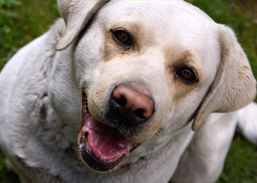Parvovirus was discovered in the canine population in 1977. It is a close relative to feline distemper and there is some speculation that it mutated and crossed species. The disease is extremely hardy and can live for 6 months to a year outside the host. If the first snowfall is before the ground freezes, the virus can be isolated beneath the snow and still be alive in the spring when the snow melts. Only extremely cold temperatures and bleach (sodium hypochlorite) can kill the virus. Because parvo is usually killed or dormant over the winter, most cases are in the warmer spring and summer months. Certain breeds such as Rottweilers, Doberman Pinschers, German Shepards, Labrador Retrievers, and Pitbulls are genetically predisposed.
Puppies receive protection in colostrum from their mothers. This protection only lasts for about four months. The pups’ protection drops by half every 7 to 10 days. The amount of colostrum each puppy gets depends on the birth order and how much each pup gets to nurse. Before the puppies are vaccinated they should not go out in public or visit with other dogs because there is a window between the time the maternal antibodies wear off and the time that puppies can be vaccinated. The most commonly affected age group is between weaning and 6 months because that is the group usually not protected by material antibodies or vaccines. Vaccination is the only way to really protect your dog and prevent this devastating disease. Puppies should receive vaccinations at 6 to 8 weeks, and again every 3 to 4 weeks until they are 12 weeks old. Boosters should be given annually and 2 weeks before breeding females to ensure good maternal antibodies.
The virus works by invading the host and inserting itself into the host cell. The virus seeks rapidly dividing cells in the body such as lymph nodes of the throat and then bone marrow and intestinal cells. In the marrow, the virus infects the young blood cells so that they cannot mature and enter the bloodstream. The white blood cell population is significantly harmed causing panleukopenia and that is a huge problem because they are the cells that fight infection. Once inside, it programs the cell to produce more virus. The incubation period is about 4 to 7 days. The cell makes more virus until the cell explodes then the disease continues and infects the bloodstream. This infection, as with all infections, is affected by the host’s vitality, virulence of the virus, and environmental factors. Animals that are vaccinated or exposed to a smaller amount of virus have an easier time fighting off the virus than do those that do not have any antibodies or are exposed to a large amount of virus particles.
The gastro-intestinal tract undergoes the most damage. The villus is the unit of the intestine that absorbs nutrients and provides a protective barrier between the gut and the internal systems. When the virus infects the villi and the crypt epithelia they become blunted and cannot absorb nutrients as the microvilli are destroyed. The sloughing of the intestinal cells into the diarrhea causes a distinct sickly-sweet smell that is indicative of parvo. This event is the breakdown of the barrier that allows the intestinal bacteria to enter the bloodstream and cause septicemia, which can be fatal to the dog. All of the fluid loss through vomiting and diarrhea cause dehydration, which can lead to shock and that is the other way a parvo patient can die. Septic puppies often develop hypoglycemia as well.
Common symptoms to look out for include lethargy, not eating, acute onset diarrhea, vomiting, high fever, neutropenia, and the ‘parvo smell’. Your vet can do an in-house blood test to diagnose parvo. The primary mode of transmission is oral-fecal and on fomites. This disease is highly contagious. For the first two weeks after infection, dogs will shed massive amounts of the virus (over 1 billion virions per gram of feces.)
Treatment includes the above-mentioned fluid therapy, antibiotics, endotoxin neutralizing products and medications to ease the GI upset. Dogs with parvo should receive nothing by mouth because they will not be able to keep it down. Dogs and puppies that have not been vaccinated do not have any anti-bodies to help fight off the virus. Blood from a dog who has survived parvo is loaded with these antibodies and would be very beneficial to helping the immune system respond to the virus. Whole blood is also necessary for severe blood loss and anemia. Drugs from your vet can help white blood cell production fight off the illness. Hetastarch is useful for pulling fluids back to where they are supposed to be when membranes are weak. Sometimes Pepto-Bismol helps ease the stomach.
If a dog with parvo can survive the first 3 to 4 days of infection they will have a good chance of making it through the illness. Younger animals have a more difficult time of surviving.
To clean up after a parvo dog, everything that can be thrown away needs to be disposed of. Any cloth products, such as gowns or towels, need to be double bagged and thrown away. Bleach everything else. After everything is bleached, keep other dogs away from the area or objects for at least two months. Once the dog is healthy they still cannot meet any other dogs for at least two months. The property should be disinfected weekly.
Studies
Antiviral activity of a bacillus sp P34 peptide against pathogenic viruses of domestic animals.
Role of mitochondria in parvovirus pathology.


